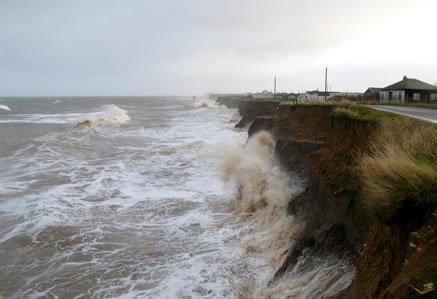Destructive waves
Find out more about destructive waves.
Constructive wave
Find out more about constructive waves.
A wave is a disturbance on the surface of the sea or ocean, in the form of a moving ridge or swell.
Find out more about waves.
Swash
Find out more about waves.
Backwash
Find out more about waves.
Corrasion is when destructive waves pick up beach material (e.g. pebbles) and hurl them at the base of a cliff. Over time this can loosen cliff material forming a wave-cut notch.
Find out more about coastal erosion.
Corrosion/solution is when certain types of cliff erode as a result of weak acids in the sea.
Find out more about the processes of coastal erosion.
Waves hitting the base of a cliff causes leads to air compression in cracks, joints and folds in bedding planes, causing repeated changes in air pressure. As air rushes out of the crack when the wave retreats, it leads to an explosive effect as pressure is released. This process is supported further by the weakening effect of weathering. The material breaks off cliffs, sometimes in huge chunks. This process is known as hydraulic action.
Find out more about coastal erosion.
The wearing away of land by the sea.
Find out more about coastal erosion.
Corrasion, abrasion, hydraulic action, attrition and corrosion/solution.
Find out more about the processes of coastal erosion.
Salt weathering is when salt spray from the sea gets into a crack in a rock. It may evaporate and crystallise, putting pressure on the surrounding rock and weakening the structure.
Find out more about weathering.
Recently weathered rock can be seen at the foot of chalk and limestone cliffs and is easily identified because it is angular.
Find out more about weathering.
Weathering is the breakdown of rock in situ by the action of rainwater, extremes of temperature, and biological activity.
Find out more about weathering.
Freeze-thaw weathering occurs when rocks are porous (contain holes) or permeable (allow water to pass through). Water enters the rock and freezes. The ice expands by around 9%. This causes pressure on the rock until it cracks. Repeated freeze-thaw can cause the rock to break up.
Find out more about weathering.
Chemical weathering is the breakdown of rock through changing its chemical composition.
Find out more about weathering.
Any three from:
- Waves enter an area of shallow water/waves enter a sheltered area, eg a cove or bay
- There is little wind
- A river or estuary flows into the sea reducing wave energy
- There is a good supply of material and the amount of material being transported is greater than the wave energy can transport.
Find out more about coastal deposition.
Solution, suspension, saltation and traction.
Find out more about coastal transportation.
Littoral drift
Find out more about longshore drift.
Traction – large pebbles and boulders are rolled along the seafloor.
Find out more about coastal transportation.
Material is dissolved and carried by the water.
Find out more about coastal transportation.
Share this:
- Click to share on X (Opens in new window) X
- Click to share on Facebook (Opens in new window) Facebook
- Click to share on Pinterest (Opens in new window) Pinterest
- Click to email a link to a friend (Opens in new window) Email
- Click to share on WhatsApp (Opens in new window) WhatsApp
- Click to print (Opens in new window) Print

